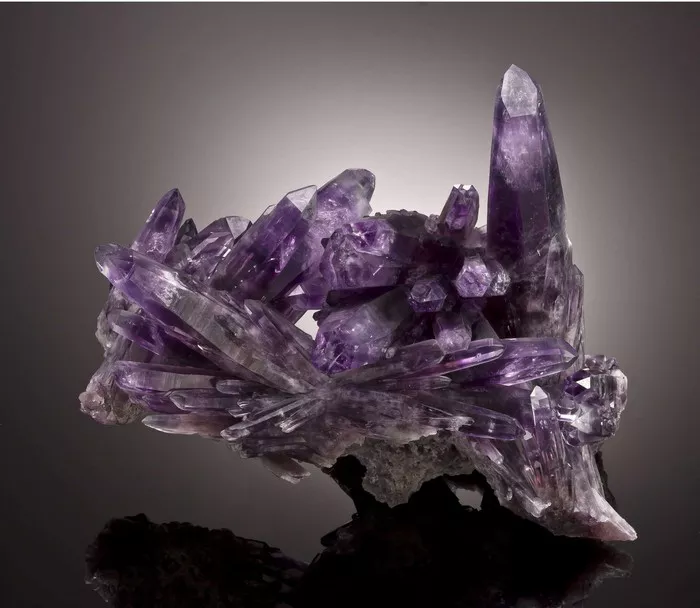Amethyst geodes, those mesmerizing natural wonders, have long captured the imagination of geologists, mineral enthusiasts, and mystics alike. These stunning geological formations, prized for their vibrant hues of purple and captivating crystalline structures, are not just decorative objects—they are windows into the intricate processes that shape our planet over millions of years. In this exploration, we delve into the depths of geological time to uncover the remarkable journey of amethyst geodes, from their humble beginnings as hollow cavities to the exquisite crystallization process that gives them their distinctive beauty.
Formation of Cavity:
Amethyst geodes begin their journey as empty voids nestled within volcanic or sedimentary rocks. The formation of these cavities is a crucial initial step in the geode-forming process, providing the canvas upon which nature paints its masterpiece.
There are several mechanisms by which these hollow spaces can originate. During volcanic activity, molten rock, or magma, surges towards the Earth’s surface. As the magma rises, volatile gases, including water vapor and carbon dioxide, become trapped within it. When the pressure decreases rapidly, such as during an eruption or volcanic degassing, these gases form bubbles within the cooling magma. As the magma solidifies to form volcanic rocks like basalt or andesite, these gas bubbles are preserved as voids within the rock matrix, creating potential sites for geode formation.
In sedimentary environments, the decay of organic material can also lead to the formation of cavities. Organic matter, such as plant roots or animal remains, can become buried in sedimentary deposits over time. As these organic components decompose, they release gases, which can create voids within the surrounding rock as they escape. Additionally, the dissolution of minerals within the rock by groundwater can create pathways and voids that serve as potential sites for geode formation.
Over millions of years, these cavities provide the starting point for the development of amethyst geodes, serving as shelters for the spectacular crystalline structures that will eventually fill them.
Silica-Rich Water Permeation:
With the stage set by the formation of these hollow cavities, the next act in the geode-forming drama begins with the infiltration of silica-rich water. Silica, in the form of silicon dioxide (SiO2), plays a central role in the crystallization process that transforms these empty voids into radiant chambers adorned with amethyst crystals.
Silica-rich water, carrying dissolved minerals acquired from the surrounding rocks, gradually seeps into the cavities over time. This water, often sourced from groundwater or hydrothermal fluids, acts as a carrier for the essential ingredients necessary for crystal growth. As the water permeates the cavity walls, it deposits its mineral cargo, gradually filling the once-empty voids with a solution saturated with silica and other dissolved elements.
The chemistry of the infiltrating water is crucial in determining the eventual color and composition of the resulting crystals. Trace elements present in the water, such as iron, manganese, and titanium, can impart subtle variations in hue, ranging from delicate lilacs to deep purples, adding to the aesthetic diversity of amethyst geodes.
Crystallization Process:
With the cavity now filled with silica-rich water and dissolved minerals, the stage is set for the main event—the crystallization process. This transformative phase is where the magic truly happens, as layers of silicon dioxide gradually precipitate out of solution to form the intricate crystalline structures that define amethyst geodes.
Under the right conditions of temperature, pressure, and chemical composition, silica molecules within the water begin to arrange themselves into orderly crystalline patterns. As successive layers of silica crystals form on the cavity walls, they slowly grow inward, gradually filling the space with a lattice of interconnected crystals.
The crystallization process gives rise to the characteristic hexagonal prism shape of quartz crystals, with six-sided pyramids, known as rhombohedrons, forming at each end. These geometrically precise structures reflect the inherent symmetry of the crystalline lattice, creating visually striking patterns that captivate the eye.
Within the confines of the geode cavity, the growing crystals compete for space, intertwining and interlocking with each other as they vie for dominance. This intense competition results in a diverse array of crystal sizes and orientations, contributing to the unique beauty of each individual geode.
As the crystallization process continues over millennia, the cavity gradually fills with layers upon layers of amethyst crystals, each one a testament to the slow but inexorable passage of geological time. The end result is a breathtaking display of natural artistry, with the once-empty voids transformed into kaleidoscopic chambers adorned with glittering crystals.
Conclusion:
In unraveling the mysteries of amethyst geode formation, we gain a deeper appreciation for the intricate interplay of geological processes that shape our planet. From the humble beginnings of hollow cavities to the breathtaking beauty of crystalline growth, each step in the journey of a geode is a testament to the transformative power of nature over vast expanses of time.
As we marvel at these radiant gems, let us not only admire their aesthetic splendor but also reflect on the profound geological forces that brought them into being. In the quiet depths of the Earth, hidden from view, a symphony of chemical reactions and physical processes unfolds, giving rise to the wonders that adorn our world. And in the heart of every amethyst geode lies a story waiting to be told—a story of formation, transformation, and the timeless beauty of the natural world.


